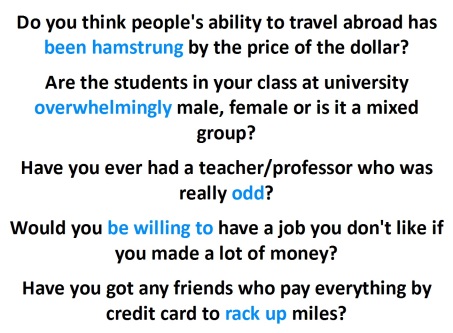I’ve recently left my job at an English Institute and started teaching more and more private students. One of the things this has allowed me to do is tackle topics that I might not have been able to in the past. Inspired by 52 I started keeping an eye out for thought-provoking articles that I could use with some of my students. Then I came across an article from The Economist, which is one of my favourite sources of authentic texts, discussing the liberalization of marijuana in the United States. That was exactly what I was looking for.
A 20-year-old C1 level student was my Guinea pig for this experiment. I started by showing him the image below and eliciting vocabulary he associated with it.

He was able to come up with quite a list of vocabulary (joint, pot, weed, cannabis, marijuana). So I asked him to try to find as many of those words as possible in the text in one minute. You can find the adapted article below and the original article here.
The Marlboro of Marijuana (The Economist)
My student was quite surprised that those words would show up in an article from a reputable magazine, so he was interested. Now I asked him to read the article in full so we could discuss the following questions:
- In which American states can you use marijuana recriationally?
- What is preventing the creation of a “Marlboro of marijuana”?
- What problems do these businesses face when looking for financing?
- According to the author, will the liberalization be good for small businesses?
- The article is full of business terms but my student was able to cope with it and answer the ‘reading for detail’ questions.
Our after-reading discussion was based on these two questions:
- Do you think marijuana might be legalized in Brazil in the near future?
- How do you personally feel about this issue?
The article was a springboard for a rich discussion about the pros and cons of legalization and who exactly would benefit from that.
That was not, however, the end of the lesson. If you look at the pdf with the adapted version of the article, you will find some vocabulary items in bold. These are the words and expressions I chose to work with. They are not necessarily the words I thought my student might not know, but the ones I thought would be useful for him in the future.
There are a couple of ways you can go about doing this. A C1 level student should be able to guess the meaning of many of these from context, so you can start here. Alternatively, you can show a mix of expressions and definitions to be matched. I’ve found the former works really well in one-to-one lessons, but the latter is better suited for larger groups.
After discussing or matching the meanings, I usually try to come up with personalized questions using the target vocabulary so my student can use it in context to talk about his own life and experiences. This is what the questions look like:
The language appears in a different colour to draw attention to the items we have just worked with. I believe this type of practice activity increases the chance my student will be able to use these words and expressions in the future.
Thanks for reading.


Congratulations on the start of your new blog! Very interesting, I’m sure you’ll come up with lots of challenging and critical lessons for class. I like the way you tackle this topic of drugs, which could get thorny I agree.The angle of legalization in the USA of pot is a good entry point I think. Anyway, all the best with it!
LikeLike
Thanks for words of support, Lindsay. 52 and the work from The Round have been an inspiration for a while.
LikeLike
Congratulations, Ricardo. May this post be the first of many! Um abraço!
LikeLike
Congrats Ricardo!!!
LikeLike
Pingback: Teaching Curse Words | ricardo barros elt
Pingback: Narcos and Breaking Bad | ricardo barros elt
Pingback: Talking about the Paris terrorist attacks | ricardo barros elt
Pingback: Wage Equality – A conversation lesson for adults | ricardo barros elt
Pingback: So Long, and Thanks for All the Fish | ricardo barros elt